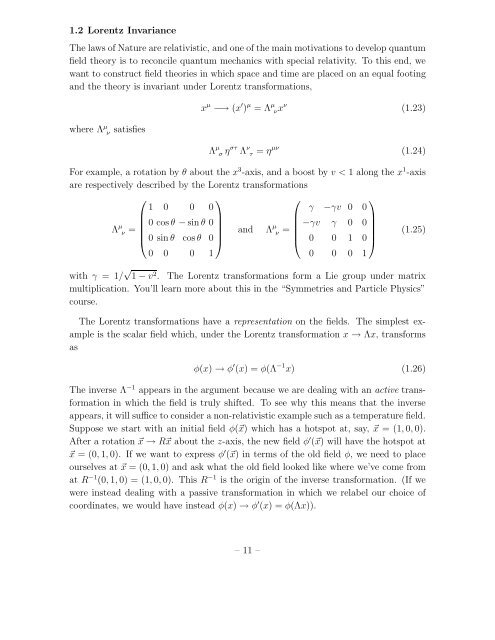Quantum Field Theory
Quantum Field Theory
Quantum Field Theory
You also want an ePaper? Increase the reach of your titles
YUMPU automatically turns print PDFs into web optimized ePapers that Google loves.
1.2 Lorentz InvarianceThe laws of Nature are relativistic, and one of the main motivations to develop quantumfield theory is to reconcile quantum mechanics with special relativity. To this end, wewant to construct field theories in which space and time are placed on an equal footingand the theory is invariant under Lorentz transformations,x µ −→ (x ′ ) µ = Λ µ νx ν (1.23)where Λ µ ν satisfies Λ µ σ ηστ Λ ν τ = ηµν (1.24)For example, a rotation by θ about the x 3 -axis, and a boost by v < 1 along the x 1 -axisare respectively described by the Lorentz transformations⎛⎞⎛⎞1 0 0 0γ −γv 0 0Λ µ ν =0 cosθ − sin θ 0⎜⎟⎝ 0 sin θ cosθ 0 ⎠ and Λµ ν =−γv γ 0 0⎜⎟ (1.25)⎝ 0 0 1 0⎠0 0 0 10 0 0 1with γ = 1/ √ 1 − v 2 . The Lorentz transformations form a Lie group under matrixmultiplication. You’ll learn more about this in the “Symmetries and Particle Physics”course.The Lorentz transformations have a representation on the fields. The simplest exampleis the scalar field which, under the Lorentz transformation x → Λx, transformsasφ(x) → φ ′ (x) = φ(Λ −1 x) (1.26)The inverse Λ −1 appears in the argument because we are dealing with an active transformationin which the field is truly shifted. To see why this means that the inverseappears, it will suffice to consider a non-relativistic example such as a temperature field.Suppose we start with an initial field φ(⃗x) which has a hotspot at, say, ⃗x = (1, 0, 0).After a rotation ⃗x → R⃗x about the z-axis, the new field φ ′ (⃗x) will have the hotspot at⃗x = (0, 1, 0). If we want to express φ ′ (⃗x) in terms of the old field φ, we need to placeourselves at ⃗x = (0, 1, 0) and ask what the old field looked like where we’ve come fromat R −1 (0, 1, 0) = (1, 0, 0). This R −1 is the origin of the inverse transformation. (If wewere instead dealing with a passive transformation in which we relabel our choice ofcoordinates, we would have instead φ(x) → φ ′ (x) = φ(Λx)).– 11 –
















